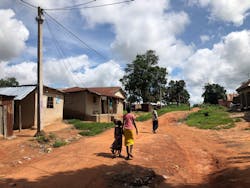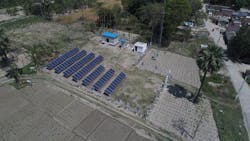For emerging markets in South Asia and Sub-Saharan Africa, transmission and distribution have long been overlooked and underinvested, despite its critical role in delivering energy services to the more than 3 billion people who still live without reliable access to electricity.
Husk Power Systems, which owns and operates the largest fleet of community solar mini-grids and T&D networks across rural Asia and Africa, works in low-voltage settings within the overall electricity supply chain and builds last-mile distribution systems that serve off-grid, weak-grid and under-the-grid communities. To date, the company has installed and maintains a distribution network of more than 600 km (373 miles) in length, serving a population of 500,000.
Mini-grids are the most cost-effective way to provide reliable three-phase alternating-current electrical infrastructure to rural and peri-urban communities. They can have major implications on enabling socioeconomic progress in the Global South. For example, extending a national grid to a community 25 km (15.5 miles) away from the point of generation or a transmission substation would require an estimated four times to five times the investment Husk makes in setting up both the generation and distribution assets.
Low-voltage distribution networks often have been neglected in terms of design innovation. However, Husk treats distribution with the same importance as it puts on the generation system in terms of quality and protection. It is investing heavily in research and development (R&D) and working to ensure last-mile electricity delivery makes an important contribution to eradicating energy poverty globally.
Levelized Cost Of Energy
In the power industry, levelized cost of energy (LCOE) generally is calculated only based on generation systems. At Husk, however, LCOE covers the complete system — from point of generation to the consumer, including the distribution assets. As a result, the company is simultaneously optimizing on multiple T&D fronts:
- Use of high-quality, tested and verified material
- Implementation of a preventive maintenance schedule to ensure the health of assets
- Reduction and management of both technical and nontechnical losses
- Deployment of monitoring systems to reduce the cost of maintenance, without compromising reliability.
Five Focus Areas
Husk focuses on five areas when it comes to its distribution systems:
1. Efficiency — Husk has designed a distribution network that ensures the aggregate technical and commercial losses are under 9%, compared to about 35% in losses by state-run distribution utilities in the markets in which Husk operates. Husk’s distribution system delivers less than 6% technical losses and has established management capabilities to control commercial losses under 3%. The major contributors to the reduction in distribution losses has been quicker response times and solving technical and theft-related issues on the grid. Husk has sized its systems using learnings from data on over 15 years of operation. Besides addressing loss reduction, another important area of focus for mini-grid operators is on phase balance, as the mix of users is still 80-to-20 between single phase and three phase, respectively.
2. Life cycle — The life cycle of the system is a critical feature in LCOE management. Thus, it is important to select the best set of components and develop management systems that will ensure they last 20 years to 25 years. Husk focuses on even the smallest items, like cable clamps. It invests heavily in testing and building quality control for all components, including the poles, AB cables and junction boxes used for power distribution. As a part of its asset management practice, the company conducts a routine survey and maintenance of the entire distribution grid to track any major challenges and take corrective actions. A quality control team has also been put into place to manage the health of the infrastructure along the life cycle of the installation.
3. Safety — An essential part of Husk’s design is safety, starting from the selection of components through to maintenance. The company has installed circuit breakers at all customer end points as a compulsory process, allowing both switching capabilities and short-circuit protection. Additionally, the distribution point on a pole has additional fault protection. Finally, the plant has multiple levels of protection, including short-circuit protection, earth-fault protection and surge protection — both from lightning and issues caused on the customer’s end.
4. Customer service — Husk’s commissioning and design processes are highly customer centric. The company ensures an average of 240 V ±10% (line to neutral) across the grid at any customer point. In addition to this, all customers have access to their power quality through Husk’s customer-facing mobile application at any point in time, including their operational load pattern. The grid infrastructure is designed to ensure most issues caused at any specific customer end point remains isolated, so other customers are not impacted. Husk has a grievance tracking system that covers all issues received from customers about potential overload conditions at their business or home. On average, all such issues are resolved in two hours.
5. Installation — Often, the process of installing distribution systems is neglected because of contractual management for ease of cost and scale. Husk avoids this pitfall by having a supervision team at various levels, including appropriate handshake processes embedded to provide quality assurance. The installation process for power distribution at Husk focuses on many simple yet critical checks related to waterlines, telecom or data lines, and underground electrical connections to ensure no damage is done to existing infrastructure. The process begins long before installation. In advance of civil works, Husk’s team invests heavily in local stakeholder engagement, making the community an integral part of the installation to ensure a smooth rollout of distribution assets. This is critical because Husk’s mini-grids are located close to main market areas, and distribution networks need to cover 80% of commercial customers to maximize both local impact and company revenue.
What Next?
Mini-grids are the most economical model to provide access to reliable, renewable, affordable and modern power to nearly 500 million people, according to the World Bank. Distribution systems are going to play a crucial role in last-mile delivery infrastructure.
As such, much greater levels of R&D are needed to increase reliability, sustainability and efficiency of distribution, with the goal of leapfrogging beyond incremental improvements and creating new paradigms, such as wireless electricity transmission or by radically reducing the cost of smart meters. Such R&D must focus on further reducing the LCOE of T&D by doubling down on digitization and automation.
Smart distribution systems will enhance customer satisfaction and ease the process of troubleshooting. The mini-grid industry goal should be to reduce the cost by 30% of operating and maintaining distribution systems over the next three years. In addition, there is an opportunity to use geographic information systems and build proprietary algorithms to achieve mapping and installation of distribution systems across 25 sites to 30 sites per month per country.
Nikhil Murarka is head of innovation and engineering at Husk Power Systems.



